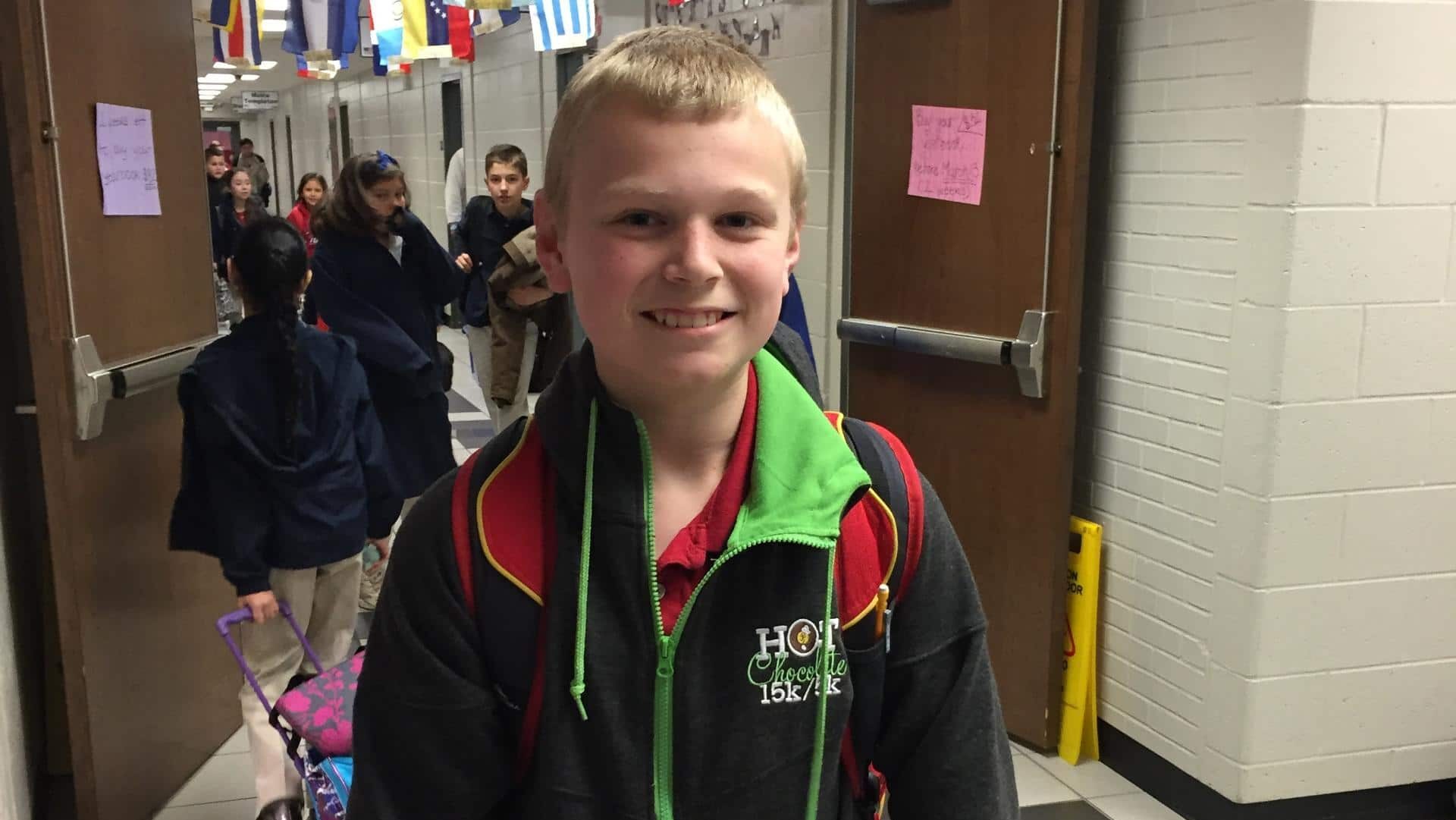Bilingual Ed in the South: Another School Across the Border (in GA)
Lesther Martin, a World Language Academy teacher originally from Guatemala, teaches his fourth-graders social studies.
As public schools become more linguistically diverse, some see bilingual or “dual-language” programs as a way to improve education for all – English speakers too. Yesterday we checked out an innovative dual-language school in a low-income Georgia neighborhood just outside Atlanta. Today we’ll visit a program 50 miles to the northeast, where staff combine the approach from that first school with resources from a more solidly middle-class community. That promising mix has become a model. Read more below, or listen above.
World Language Academy is a place where the middle school has an indoor multi-floor “learning commons” some colleges would envy, and the program’s

Dan Carsen
The “Learning Commons” at WLA’s middle school.
foundation helps buy duplicate materials written in multiple tongues. It’s a place where first-graders of all backgrounds talk about butterflies in Spanish, and where white middle-schoolers speak Spanish – or Mandarin – in the halls. The largest proportion of the student body is Latino, then white, then smaller numbers of blacks and Asians. And students aren’t the only ones connecting across cultures.
“I feel like I’ve been a bubble my whole life. And coming here, I’m the minority,” says Lane Sharrett, a fourth-grade teacher who is white.
She grew up nearby in Flowery Branch, Georgia, and unlike many of her colleagues, who hail from more than a dozen mainly Spanish-speaking countries,she teaches in English. She admits that in her youth, she and everyone she knew assumed “any Latino was Mexican.” She’s learned a lot about cultures and about bilingual education since then. Her students’ (and the whole schools’) test scores are very good, even though the tests are in a language in which her kids are taught just half the time:
“My students are on third-grade reading levels here, but they’ve only really gotten half of their day in [English], and they’re still meeting – actually more or less exceeding – where they’re supposed to be,” she says.
Those kinds of results, and the bilingual or dual language approach in general, demand tremendous teamwork at WLA’s preschool, elementary, and middle-school campuses.
“I have to trust that the Spanish teacher is teaching the standards that need to be taught for my students, and vice-versa,” Sharrett explains. “There’s a lot of collaboration to make sure that we’re hitting all those standards. You have two totally different teachers, two totally different cultures coming together.”
But when kids who don’t speak English come together in traditional English immersion classrooms – the most common approach across the South and the U.S. –the message many get is that their language is less valued, and educators say they can internalize that. WLA teacher and bilingual education advocate Jason Mizell is one of them:

Dan Carsen
Estudiantes y mariposas: First-grade teacher Vivianne Delgado and her students are learning about butterflies, but they’re also learning to describe and associate in Spanish.
“If you make a kid feel valued, they will do anything for you. But the moment you make them feel you have something against them, they shut down. In a dual-language school, that’s one hurdle you don’t have to go over. Kids know that they’re valued, their families are valued.”
And people from the dominant language group can benefit too, people like Skyler, who’s in eighth grade and loves writing.
“It’ll give me a lot more job opportunities – I’ll be able to translate for some companies,” he says.
But after so many reports about how being bilingual boosts brain development, I’m curious about something else. I ask the budding language-hopper if he thinks in Spanish. He does:
“Sometimes it’ll just get into me, and I’ll just start thinkin’ in Spanish, and I don’t realize it. And then I’ll go back to English and I won’t even notice.”

Dan Carsen
Skyler is in the eighth grade at World Language Academy. He hopes his knowledge of Spanish will help him get better jobs. He also dreams in Spanish. For more on him or WLA, see Part Two of this series.
WLA elementary parent Harmon Tison sees that kind of development in his fourth-grader and second-grader. They helped the family traveling in rural Costa Rica, including haggling in open-air markets where prices are “negotiable.” But their learning core subjects in Spanish comes with some frustrations: Tison can’t help his kids with their homework, which he says has helped him understand what language-minority parents face all the time.
“A lot of times, human nature is selfish,” he says. “You don’t realize the decisions you make, the impact they have on other people, not only in your community, or in your state, or maybe in your country, or maybe even the world. And we want ‘em to be able to think outside the box and be able to realize we’re all in this together.”
Most language-minority students don’t have access to anything like this well-funded and well-run Georgia school. And even the best possible dual-language program wouldn’t fix everything many of these kids face: “triple-segregation” by ethnicity, poverty, and language. But teaching them in the language they know at a critical period in their lives is pushing some over those hurdles, and widening the worldviews of others with fewer hurdles.
How Alabama Power kept bills up and opposition out to become one of the most powerful utilities in the country
In one of the poorest states in America, the local utility earns massive profits producing dirty energy with almost no pushback from state regulators.
No more Elmo? APT could cut ties with PBS
The board that oversees Alabama Public Television is considering disaffiliating from PBS, ending a 55-year relationship.
Nonprofit erases millions in medical debt across Gulf South, says it’s ‘Band-Aid’ for real issue
Undue Medical Debt has paid off more than $299 million in medical debts in Alabama. Now, the nonprofit warns that the issue could soon get worse.
Roy Wood Jr. on his father, his son and his new book
Actor, comedian and writer Roy Wood Jr. is out with a new book -- "The Man of Many Fathers: Life Lessons Disguised as a Memoir." He writes about his experience growing up in Birmingham, losing his dad as a teenager and all the lessons he learned from various father figures throughout his career.
Auburn fires coach Hugh Freeze following 12th loss in his last 15 SEC games
The 56-year-old Freeze failed to fix Auburn’s offensive issues in three years on the Plains, scoring 24 or fewer points in 17 of his 22 league games. He also ended up on the wrong end of too many close matchups, including twice this season thanks partly to questionable calls.
In a ‘disheartening’ era, the nation’s former top mining regulator speaks out
Joe Pizarchik, who led the federal Office of Surface Mining Reclamation and Enforcement from 2009 to 2017, says Alabama’s move in the wake of a fatal 2024 home explosion increases risks to residents living atop “gassy” coal mines.









